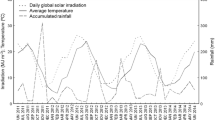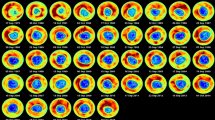Abstract
To gain insight into enhanced ultraviolet-B (UV-B) radiation effects on agroecosystem respiration rates and nitrous oxide (N2O) emissions, pot and field experiments were conducted in the 2004 and 2006 soybean-growing seasons, respectively. The enhanced UV-B radiation treatments were simulated by a 20% increase in its intensity. The respiration rates and N2O fluxes were measured by a static opaque chamber–gas chromatograph method. Results showed that the enhanced UV-B radiation did not change the seasonal patterns of ecosystem respiration and N2O emission. Compared to the controls, however, the enhanced UV-B reduced the respiration rates by 43.3% (P = 0.015) and 44.8% (P = 0.002) over the entire soybean-growing seasons in 2004 and 2006, respectively. Similarly, the enhanced UV-B radiation reduced seasonal N2O emissions by 33.5% (P = 0.023) and 42.4% (P = 0.006) in 2004 and 2006, respectively. Our findings suggest that enhanced UV-B radiation may lead to a decrease in agroecosystem respiration rates and N2O emissions from croplands. To estimate the overall effects of enhanced UV-B radiation on greenhouse gas emissions from agroecosystems, nevertheless, more field measurements deserve to be carried out in various cropping systems.




Similar content being viewed by others
References
Chang C, Janzen HH, Cho CM, Nakonechny EM (1998) Nitrous oxide emission through plants. Soil Sci Soc Am J 62:35–38
Conrad R, Seiler W, Bunse G (1983) Factors influencing the loss of fertilizer nitrogen into the atmosphere as N2O. J Geophys Res 88:6709–6718. doi:0148-0227/83/003C-0545
Del Grosso SJ, Parton WJ, Mosier AR, Ojima DS, Kulmala AE, Phongpan S (2000) General model for N2O and N2 gas emissions from soils due to denitrification. Global Biogeochem Cycles 14:1045–1060. doi:0886-6236/00/1999GB001225
Firestone MK, Davidson EA (1989) Microbiological basis of NO and N2O production and consumption in soil. In: Andreae MO, Schimel DS (eds) Exchange of trace gases between terrestrial ecosystems and the atmosphere. Wiley, Chichester, pp 7–21
Ghisi R, Trentin AR, Masi A, Ferretti M (2002) Carbon and nitrogen metabolism in barley plants exposed to UV-B radiation. Physiol Plant 116:200–205. doi:10.1034/j.1399-3054.2002.1160209.x
Hakata M, Takahashi M, Zumft W, Sakamoto A, Morikawa H (2003) Conversion of the nitrate nitrogen and nitrogen dioxide to nitrous oxides in plants. Acta Biotechnol 23:249–257. doi:10.1002/abio.200390032
IPCC (2007) Climate change 2007: the physical science basis. Contribution of working group I to the fourth assessment report of the intergovernmental panel on climate change. Cambridge University Press, Cambridge
Johnson D, Campbell CD, Lee JA, Callaghan TV (2002) Arctic microorganisms respond more to elevated UV-B radiation than CO2. Nature 416:82–83
Johnson D, Campbell CD, Lee JA, Callaghan TV, Gwynn-Jones D (2003) Nitrogen storage (communication arising): UV-B radiation and soil microbial communities. Nature 423:138
Kadur G, Swapan B, Sunita K, Sanjeev Y, Arjun T, Sanjay B, Abhinav R, Mohanty P (2007) Growth enhancement of soybean (Glycine max) upon exclusion of UV-B and UV-B/A components of solar radiation: characterization of photosynthetic parameters in leaves. Photosynth Res 94:299–306. doi:10.1007/s11120-007-9190-0
Kakani VG, Reddy KR, Zhao D, Sailaja K (2003) Field crop responses to ultraviolet-B radiation: a review. Agric For Meteorol 120:191–218. doi:10.1016/j.agrformet.2003.08.015
Kaurola J, Taalas P, Koskela T, Borkowski J, Josefsson W (2000) Long-term variations of UV-B doses at three stations in northern Europe. J Geophys Res 105:20813–20820. doi:0148-0227/00/2000JD900258
Li Y, Yang JL, Wang XL, Hu ZD (1999) The effect of UV-B radiation on the population quantity of spring wheat rhizosphere microorganisms. China Environ Sci 19:157–160 (in Chinese)
Li Y, Zu YQ, Chen JJ, Chen HY (2002) Intraspecific responses in crop growth and yield of 20 soybean cultivars to enhanced ultraviolet-B radiation under field conditions. Field Crops Res 78:1–8. doi:S0378-4290(02)00084-9
Li YY, Chen GX, Xu H, Zhang Y, Zhang XD (2003) The contribution of maize and soybean to N2O emission from the soil–plant system during seedling stage. Environ Sci 24:38–42 (in Chinese)
Moorhead DL, Callaghan TV (1994) Effects of increasing UV-B radiation on decomposition and soil organic matter dynamics: a synthesis and modeling study. Biol Fertil Soils 18:19–26
Niemi R, Martikainen P, Silvola J, Wulff A, Turtola S, Holopainen T (2002) Elevated UV-B radiation alters fluxes of methane and carbon dioxide in peatland microcosms. Glob Chang Biol 8:361–371
Quaggiotti S, Trentin AR, Vecchia FD, Ghisi R (2004) Response of maize (Zea mays L.) nitrate reductase to UV-B radiation. Plant Sci 167:107–116. doi:10.1016/j.plantsci.2004.03.005
Reddy KR, Kakani VG, Zhao D, Mohammed AR, Gao W (2003) Cotton responses to ultraviolet-B radiation: experimentation and algorithm development. Agric For Meteorol 120:249–266. doi:10.1016/j.agrformet.2003.08.029
Robson TM, Pancotto VA, Ballaré CL, Sala OE, Scope AL, Caldwell MM (2004) Reduction of solar UV-B mediates changes in the Sphagnum capitulum microenvironment and the peatland microfungal community. Oecologia 140:480–490. doi:10.1007/s00442-004-1600-9
Rochette P, Angers DA, Belanger G, Chantigny MH, Prevost D, Levesque G (2004) Emissions of N2O from alfalfa and soybean crops in eastern Canada. Soil Sci Soc Am J 68:493–506
Ryan MG, Lavigne MB, Gower ST (1997) Annual carbon cost of autotrophic respiration in boreal forest ecosystems in relation to species and climate. J Geophys Res 102:28871–28883. doi:0148-0227/97/97JD-01236
Searles PS, Kropp BR, Flint SD, Caldwell MM (2001) Influence of solar UV-B radiation on peatland microbial communities of southern Argentina. New Phytol 152:213–221
Sun WJ, Huang Y, Chen ST, Zou JW, Zheng XH (2007) Dependence of wheat and rice respiration on tissue nitrogen and the corresponding ner carbon fixation efficiency under different rates of nitrogen application. Adv Atmos Sci 24:55–64
Wang YS, Wang YH (2003) Quick measurement of CH4, CO2 and N2O emissions from a short-time ecosystem. Adv Atmos Sci 20:842–844
Weatherhead EC, Reinsel GC, Tiao GC, Jachkman CH, Bishop L, Hollandsworth Frith SM, DeLuisi J, Keller T, Oltmans SJ, Fleming EL, Wuebbles DJ, Kerr JB, Miller AJ, Herman J, McPeters R, Nagatani RM, Frederick JE (2000) Detecting the recovery of total column ozone. J Geophys Res 105:22201–22210. doi:0148-0227/00/2000JD900063
Yan X, Shi S, Du L, Xing G (2000) Pathways of N2O emission from rice paddy soil. Soil Biol Biochem 32:437–440. doi:S0038-0717(99)00175-3
Yao YN, Yang YQ, Li Y, Lutts S (2008) Intraspecific responses of Fagopyrum esculentum to enhanced ultraviolet B radiation. Plant Growth Regul 56:297–306. doi:10.1007/s10725-008-9309-0
Zou JW, Huang Y, Sun WJ, Zheng XH, Wang YS (2005) Contribution of plants to N2O emissions in soil-winter wheat ecosystem: pot and field experiments. Plant Soil 269:205–211. doi:10.1007/s11104-004-0484-0
Acknowledgments
This work was supported by grants from the National Natural Science Foundation of China (40605029), the China Postdoctoral Science Foundation (20070420195) and the State Key Laboratory of Soil and Sustainable Agriculture Foundation (0812000053). We thank Professor Y. Huang and W. Sun for their considerable help with the experimental design.
Author information
Authors and Affiliations
Corresponding author
Rights and permissions
About this article
Cite this article
Hu, Z., Jiang, J., Chen, S. et al. Enhanced UV-B radiation reduced soil-soybean ecosystem respiration and nitrous oxide emissions. Nutr Cycl Agroecosyst 87, 71–79 (2010). https://doi.org/10.1007/s10705-009-9313-4
Received:
Accepted:
Published:
Issue Date:
DOI: https://doi.org/10.1007/s10705-009-9313-4




